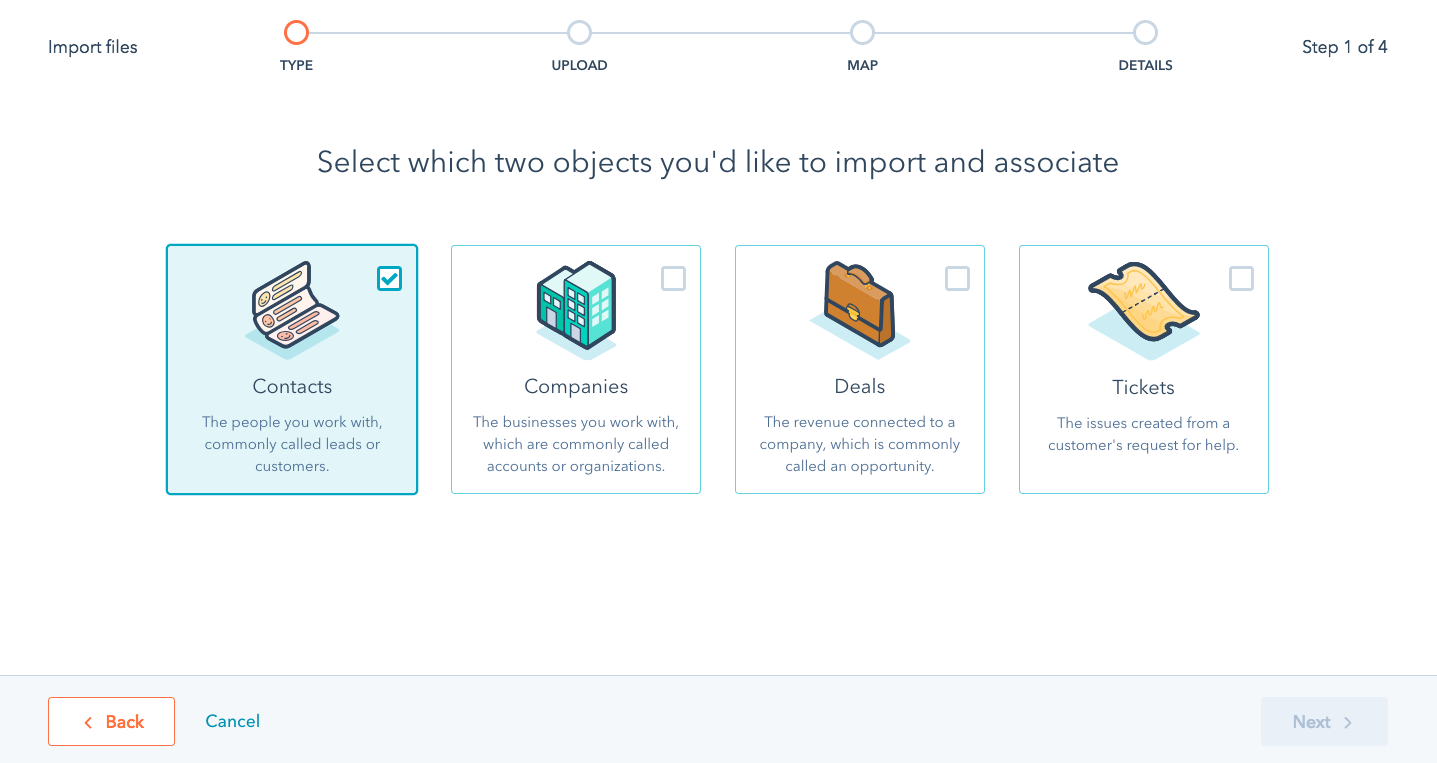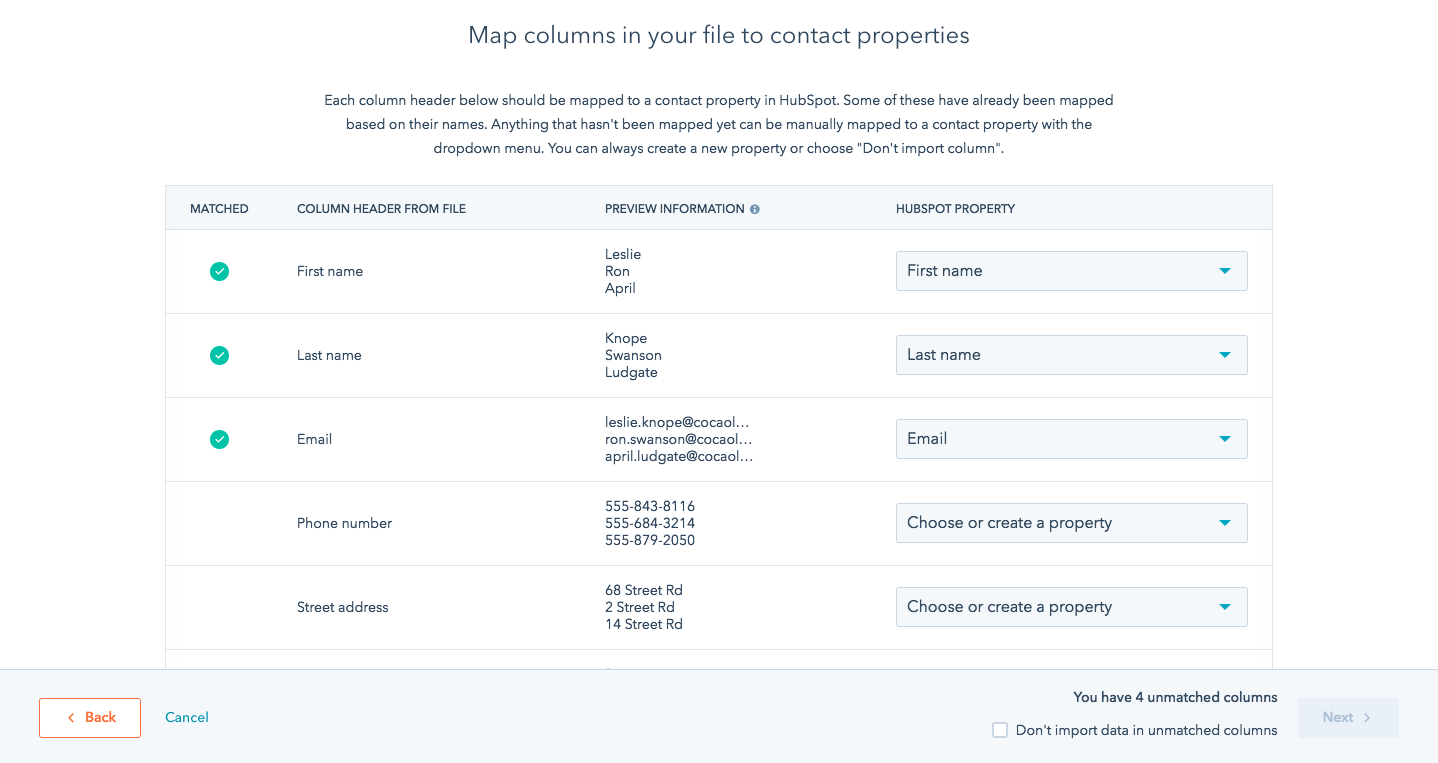How Do You Upload an Image to Hubspot
Welcome to HubSpot CRM! Whether yous were previously using another CRM, have been working in Excel for years, or have utilized viscid notes equally your system of record, your adjacent logical question is probable: "How will I store my data moving forward, and how will I get it all into HubSpot?" The purpose of this folio is to review, at a high-level, how HubSpot's CRM is structured and to give you all the data yous'll need to motility your information into it. Importing Data Into HubSpot
Why Import into HubSpot?
-

Quick and like shooting fish in a barrel imports
Getting your information into HubSpot is simple. Export all your records from your current system, and import them into HubSpot with a few clicks. No fancy data piece of work necessary. HubSpot deduplicates your records for yous, so your database is make clean and organized from the start. Plus, create custom properties as you go, so your data matches your company'due south setup.
-

All your information in 1 place
Import all your records in i get. Bring contacts, companies, deals, tickets, and more into HubSpot at in one case, and associate them together with elementary column-mapping. No manual associations necessary.
-

Go powerful insights, populated automatically
HubSpot CRM automatically populates new contact, company, and deal records with details from its database of over xx million businesses. All y'all need is a prospect's corporate email address. You'll spend less time hunting down information nigh prospects and companies, and more than fourth dimension delighting your customers.
How to Import Your Data into HubSpot
In any CRM, data is stored on objects. An object is, quite simply, a type of record that stores a certain category of information. On a given object, data is housed in backdrop, which provide specific characteristics about their containing object. HubSpot CRM is centered around four standard objects: Contacts, Companies, Deals, and Tickets. Each holds a unlike type of data, and can be linked to the other iii in a specific way. Before going any further, it's pivotal to accept a firm grasp of these four standard objects.

Contacts
These are the individuals you are going to interact with. The ones you'll be calling and send emails to in order to kickoff, keep, or maintain a business a relationship. A Contact record volition store information like First Name, Final Proper noun, Email, and Telephone Number. It will likewise include a history of when and who concluding contacted them.
Each contact tin only be associated to one company, but tin can be associated with multiple Deals and/or Tasks.

Companies
Companies are the businesses where your Contacts work. You may take more one contact that you engage with who work at the same Visitor. A Company record volition store information similar Name, Domain, Industry, and Phone Number. This is besides where you'll store information like what city the business is located in, how many employees they have, and revenue information.
Companies tin can have multiple Contacts, Deals, and/or Tasks associated.

Deals
Deals are used to manage your sales procedure and track the acquirement associated with a potential sale. Deals will move through stages, starting at the beginning of the sales process and catastrophe with a sale (Closed Won) or not (Closed Lost). The Deal record will store the amount of the potential auction, when the sale is expected to shut, and who is managing the sale.
Each Bargain can just be associated with one Visitor, only can exist associated with multiple Contacts.

Tickets
Tickets are the service interactions you take with your customers. Tickets (like deals) will motion through stages, from "created" to "closed." Tickets will shop information like source, time to outset agent respond, and time to close.
Tickets tin be asssociated with any Contact, Company, and/or Deal. They can exist associated to simply i object, or whatsoever combination.
Moving to a new CRM might seem intimidating --- there are a lot of moving parts, and the last thing you lot want is to lose whatever of your organization's vital historical data. In moving to HubSpot CRM, there are a few piece of cake ways to get started, and we're here to assistance at every stride of the way. Before importing data, however, it's important to ensure its cleanliness. As yous scrub your data, note the following:
- When you add Contacts to HubSpot CRM, the system will deduplicate by electronic mail accost.
- When you add Companies to HubSpot, the organization will deduplicate by Company Domain Name.
- When you add new Deals or Tickets, there is no deduplication.
- To brand the import process as efficient as possible, define and create your custom properties in HubSpot CRM before y'all begin.
- When yous're ready to import, start with a small sample set of your information, to ensure that everything goes as planned. Once yous're satisfied, continue with the remainder of the process.
Migrating Data into HubSpot CRM
In one case you've cleaned your data and prepared for the migration, there are several methods of bringing your existing records into HubSpot. The best option for your organization depends on the type of data yous have and the internal resources available to you. Below, nosotros've outlined the basics of the four approaches to migrating data.

Pros
- Assistance from HubSpot Support
- To the lowest degree technical route
Cons
No tasks or engagements (notes, calls, emails) tin can be imported via CSV.

Pros
- Native integration
- Aid from HubSpot Back up
- Can import data to all objects
Cons
- All objects must be associated with a Salesforce Contact or Lead in social club to sync
- All Contacts and Leads must have an email accost in order to sync
- Requires HubSpot Marketing or HubSpot Sales Pro subscription

Third-Political party Systems
Pros
- Boosted platforms are available for import. Companies likeImport2andTrujay Groupprovide data migration services from nearly every major CRM on the market.
Cons
- Cost associated
- Limited object back up from certain platforms
- Cannot utilize HubSpot Support

Pros
- Custom, personalized solution to fit your needs
- Technical assistance with more complex migrations / imports
- Can piece of work via phone and/or in person to ensure setup is completed

Pros
Can import data to all objects
Cons
- Requires internal evolution resource, not provided past HubSpot
- Back up is limited to Developer forums
- Near technical route
Source: https://www.hubspot.com/sales/crm-import
0 Response to "How Do You Upload an Image to Hubspot"
Post a Comment